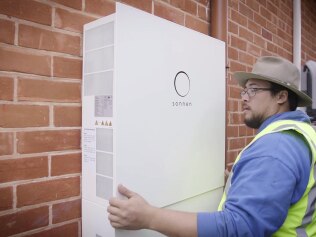Power up to reduce electricity bills
How you can use State Government subsidies and low-interest finance to afford a home battery and beat your next electricity bill.

How you can use State Government subsidies and low-interest finance to afford a home battery and beat your next electricity bill.
The advent of home battery storage for the electricity generated by solar panels is driving a revolution in the way people manage the source and cost of their home energy needs. Now, government subsidies of up to $6000 per property for batteries, and $100 million in low-interest loans to help pay for batteries and new solar panels, will mean even more South Australians can access that revolution.
The subsidies mean cheaper access to batteries and solar panels, which means more households will have the benefit of lower electricity bills by virtue of drawing less energy from the grid.In environmental terms, more home battery systems will reduce demand on the electricity network – especially during peak periods – lowering energy prices for all South Australians.
The Home Battery Scheme subsidy is available to up to 40,000 residential properties in this state, with more than 1350 already having successfully signed up. The scheme itself has broadened from its initial stages to offer access to 70 system providers who are now qualified to sell and install eligible batteries, as well as 11 battery brands and more than 170 eligible systems assessed as safe and reliable for home use.While the subsidy is available to any household connected to the state’s electricity grid – with differing amounts for different capacity batteries – Energy Concession Holders can qualify for a larger subsidy, to help low-income households to access the scheme.
Those who are granted a subsidy can also apply for finance through the Commonwealth Government’s Clean Energy Finance Corporation to help pay for the balance of the battery and to purchase new or additional solar panels.For those considering whether to jump now or wait to apply, subsidy levels and the $6000 cap are expected to reduce over time as competition in the market increases and the cost of battery systems fall.
The current subsidy is calculated on the kilowatt hour (kWh) capacity of the battery being installed, with energy concession holders eligible for $600/kWh and all other households eligible for $500/kWh.Battery owners are also able to choose whether or not their system operates as part of a virtual power plant, where people band together battery systems for access to more power at different times. A home battery system typically includes a battery and an inverter, paired with existing or new rooftop solar panels. If you want a home battery that provides uninterrupted electricity in the event of a blackout, additional equipment needs to be installed.
IS A HOME BATTERY FOR ME?
Even with a subsidy and low-interest loans, purchasing a home battery and, for some households, new solar panels, is a financial commitment that will take a number of years to reap returns and justify the initial investment.For that reason, asking the right questions at the outset is vital to ensure the right outcomes.
Chris Williams, chief executive officer of qualified system provider Natural Solar, says the key questions range from the financial to the philosophical.He says for those who have neither a home battery nor solar panels, the first question is simple: “Do you have available roof space for solar panels because, if you don’t, the battery is redundant.” If your roof allows for enough access to sunlight to warrant the installation of panels, he says the next step is to grab a copy of your latest electricity bill and find out how many kilowatt hours of power you use each day. Then assess how much of that power you use during daylight hours and how much at night.
“What we are trying to drag out of the data is how much power is the household using at night when the solar is not operating and can we generate enough during the day to store that throughout the day in the battery to discharge in the evening,” Williams says.“If you are using less during the day and more at night, you would gravitate towards a larger battery.”
For smaller households who consume less power in general, a smaller battery may be in order, although Williams warns that depending on the size of electricity bills, such households may find it harder to break even on their investment. For the rare households that do not use any power at night, a battery is pointless. “Most people use about 65 to 70 per cent of power in the evening and therefore a large battery does make sense,” he adds.
Overall, planning ahead for a household’s future energy needs is key: “Do we expect electricity consumption to increase? Are you perhaps looking at an electric vehicle, do you have kids who are getting older and perhaps using more power, might there be someone at home during the day using power? These are the variables to consider,” he says.
If you decide a battery is for you, consider whether you have a suitable place for it. Battery systems can’t be installed in habitable rooms – including a lounge, dining or bedroom – with garages the preferred site. If you have no space undercover, an outdoor enclosure may have to be built, usually on the outside wall of your house.Williams also recommends you consider the goals of your household: “Is your motivation purely a reduction in carbon emissions? That changes the weight of the financial return in your equation. Or is the motive purely to get your electricity bills down to make the system cash-flow positive?”
In the latter case, he advises comparing how much your energy costs will fall post solar and battery installation and consider whether you will at least break even after paying off the finance used to pay for the scheme over a number of years.“Is the cost of the finance and principal actually going to be less than the saving on the bill?” he asks. “Quite often it’s ‘yes’, with the help of the subsidy, in which case you are cash flow positive and you own the asset after five to seven years.”
Williams says the best return on investment on a solar and battery system his company was observing outside of South Australia was six to eight years. “It’s really exciting to see that extra subsidy up to $6000, which pushes it over that tipping point which gets a five to five-and-a-half-year return on investment for a technology that has a warranty period of 10 years but is expected to last for 20 years,” he says.
While any South Australian household connected to the grid is eligible for a subsidy, the low-interest finance is subject to credit approval.He says households who currently have the benefit of a very generous statutory feed-in tariff under an old statutory feed-in scheme should check with their retailer first to find out how adding a battery will affect the feed-in tariff they receive.
WHAT’S IN A BATTERY?
Consider what you are looking for in a battery. Each battery has a specific cycle life – the period in which a battery is fully charged and then discharged is one cycle – and some batteries guarantee more cycles over their lifetime then others. These are usually more expensive but should last longer and give you a better return on investment.“The return on your investment might be over seven or eight years, but what about after that?” Williams asks. “How long will that system actually function for? The longer it works the greater the return you are going to get.”
WHAT’S NEXT?
Households considering home battery installation should seek a detailed analysis when getting a quote from a qualified system provider. As with any significant purchase, it is recommended that households get quotes from several different providers.To find out more and start making your own calculations, go the dedicated state government website www.homebatteryscheme.sa.gov.au or call 8463 3555. There you can find the contact details of qualified system providers, view eligible battery systems and request a quote.
CASE STUDIES
JOHN PAYNTER at Andrews Farm
At age 70, semi-retired John Paynter is a savvy power consumer. He and wife Brenda have long been interested in installing a home battery to complement their solar panels but, in John’s view, the technology wasn’t viable.“The new batteries are a viable technology and they are affordable and there is a reasonable pay back time on the battery,” he now concludes.
“I’ve always believed in doing it – I’m a building surveyor by profession and I assess energy efficiency daily when I am approving buildings.”He had a 10kw sonnen battery installed using the full subsidy and upgraded his existing solar panels to 5.4kw.“My previous bill was $684. We put the system in on November 2 and first bill came nine days later and we got a $58 rebate,” he says. “I was flabbergasted – my jaw dropped.“My last full bill came the other day and we got $159 rebate for the quarter.”
John says the economics of his situation were such that he would have bought the battery even without the subsidy: “We originally worked out it would take eight years to break even – with the rebate I’m thinking it’s down to about four to five years. That puts it in the realms of being affordable.“Sometimes on a very hot day the airconditioner draws more power than the system puts out, but not usually. It takes it out of the battery first until the battery is discharged. For me it’s a bonus, I like the way it works.“Hopefully this battery will see us out and, at the end of the day, we will have no more power bills.”
RAY O’HARA at North Brighton
Finance broker Ray O’Hara and partner Sonja have been thinking about installing a home battery ever since they built their four-bedroom North Brighton home, including solar panels, about three years ago. Ray says it was the availability of the home battery subsidy that finally made it an affordable proposition.The couple’s goal was to install a battery – a 10kW sonnen unit which cost $9000 after the subsidy – while they could afford it so that they would not have to face huge electricity bills in their 70s and 80s.
“I’m 65 and today I can afford $9000 for a battery because I’ve got my own business,” he says. “But, without the battery, in 15 years’ time when I’m 80, when electricity prices have gone up, I don’t know if I can afford to be paying bills of $650 or more. I might be looking at this bill and saying ‘I can’t afford this electricity’.” Ray says his first full-quarter electricity bill since installing the battery put a smile on his face: “Seeing the bill in black and white was important to me. When I saw there was a 2 cent credit, I thought ‘I’m not going to spend any money this quarter’.”
He says the prospect of paying nothing in summer and a few hundred dollars during winter is liberating, but people need to be aware that their power production will ebb in winter.“Through winter ... you will (probably) have to be buying it from the grid most of the day,” he says.He believes he will break even on the cost of the battery in five to six years and in any case has added value to his house. “The battery has a 10-year warranty and 20-year lifespan but I may not be living here then but, what it also does, is make my house a really saleable product,” Ray says.


